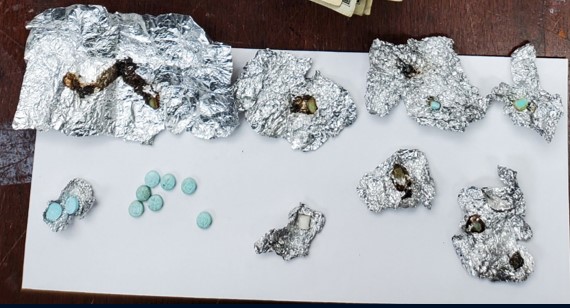Police educate Culmore residents about fentanyl abuse

Fentanyl is a huge problem in the Culmore area, so the Culmore and Bailey’s Crossroads Place-Based Initiative hosted an information session for residents on May 7, which happened to be Fentanyl Awareness Day.
Fentanyl is most commonly seen in that area in the form of pills, said MPO Stacy Sassano, the crime prevention officer at the Mason Police District. They are usually blue but also come in rainbow colors, are often called blues or perc 30s on the street, and can cost as little as $5 a pill.
Six out of 10 pills with fentanyl have enough to be a lethal dose, Sassano told community members at Bailey’s Elementary School.
While fentanyl can be legally prescribed for pain, there’s no way to know how much fentanyl is in an illegal pill sold on the street until you take it. Even a tiny amount can cause an overdose, Sassano said.
Related story: Healthcare, education, safety initiatives in the works for Culmore
Among youths ages 10-19, “fake pills are to blame for almost 25 percent of poisoning and overdose deaths,” she said. Most fatal and nonfatal fentanyl overdoses affect people ages 25-34.
People take fentanyl because it’s a sedative that makes them feel euphoric. But because it’s a short-term high, people often take it throughout the day, she said.

Fentanyl users in the Culmore area tend to grind up the pills, put them in foil and smoke them with a straw or rolled-up dollar bill, said Sassano. Pills or powder in small baggies or nonlabelled prescription bottles are usually illegal.
Youths use the private messaging features on TikTok, Snapchat, and Instagram to buy and sell drugs and use a constantly changing range of emojis to indicate where to get them and how much they cost.
Signs of an overdose include trouble breathing, extremely pale and clammy skin, vomiting, choking or gurgling noises, purple or blue nails, and the inability to speak or be woken up.
The only way to reverse an overdose is to administer Naloxone, also called Narcan. Common myths about treating overdoses, such as ice baths and coffee, don’t work, said Allison West, care coordination manager for George Mason University’s Mason and Partners Clinics.
Related story: Town hall at Justice High School addresses fentanyl overdoses
West handed out free Narcan nasal sprays and explained how to use them. Even if the victim revives, she advises calling 911 as there might be other drugs in their system.
Sassano urged people to call the police if they see someone passed out; suspicious activity, such as multiple people going in and out of a building day and night; people hiding things in bushes; a hand-to-hand drug deal; someone who is obviously high; or graffiti on your building.
The latter is important because sometimes people smoking fentanyl burn messages on a wall. Graffiti could indicate a drug dealer advertising their product, as well as a gang marking territory. Submitting a photo or video to the police is helpful, too.

There’s a lot of shoplifting in areas with fentanyl use, she said. To afford drugs, people steal items from grocery stores and drugstores and sell them on the street at half price. So, she advises calling the police if you see people selling things on a blanket spread on the ground. Those sellers aren’t likely to have the required license.
When you call the police, you don’t have to give your name, Sassano said. If someone calls 911 about an overdose, the victim won’t be charged with a crime as long as they agree to get treatment.
Don’t avoid calling the police if you’re worried about your immigration status, she said. The police will not report you to ICE.
Sassano advised the audience that parents and school officials have the right to search a youth’s room and backpack if they suspect they’re using drugs.
Indications that a youth is using fentanyl include academic problems, sudden rebelliousness, new friends, psychosis, hallucinations, confusion, and low energy.
A fentanyl overdose can happen to anyone. In a video shared at the meeting, the parents of Cayden Foster, a student at Centreville High School, spoke about his fatal overdose on Jan. 31, 2023. “We had no idea he was engaged in risky behavior,” his mom said. He had no history of drug use.
“This is not a mistake you learn from,” Cayden’s dad said. “This is a mistake that kills you.”

